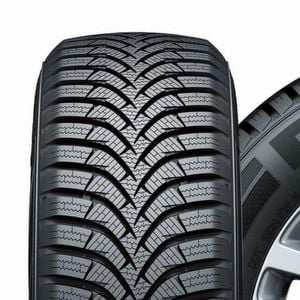Last Updated on 18.12.2024 by hrushetskyy
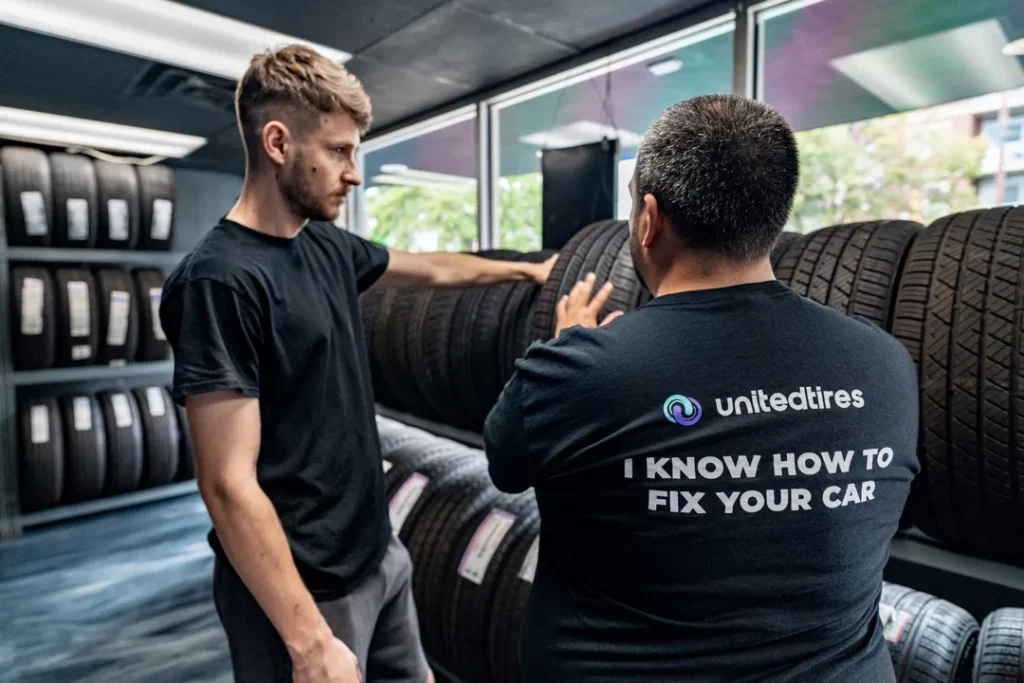
If you’re looking for a fresh set of tires, buying used tires is a very reasonable cost-saving option. However, to be absolutely sure of high quality and safety, it’s essential to buy only from trusted retailers—whether online or in-store. So, if you’re trying to figure out where to buy used tires, you’re in the right place: our expert outlines the pros and cons of each popular option.
Buying quality used tires: the most popular options
There are several places and services you can visit to buy used tires:
- Local tire store
- Auto repair shop
- Auto parts shop
- Junkyard
- Online marketplace
- Online used tire store
Many of these places offer brand-name tires at lower costs. But you have to choose wisely!
Where to buy used tires? Pros and cons of each option
Local tire stores and auto parts stores
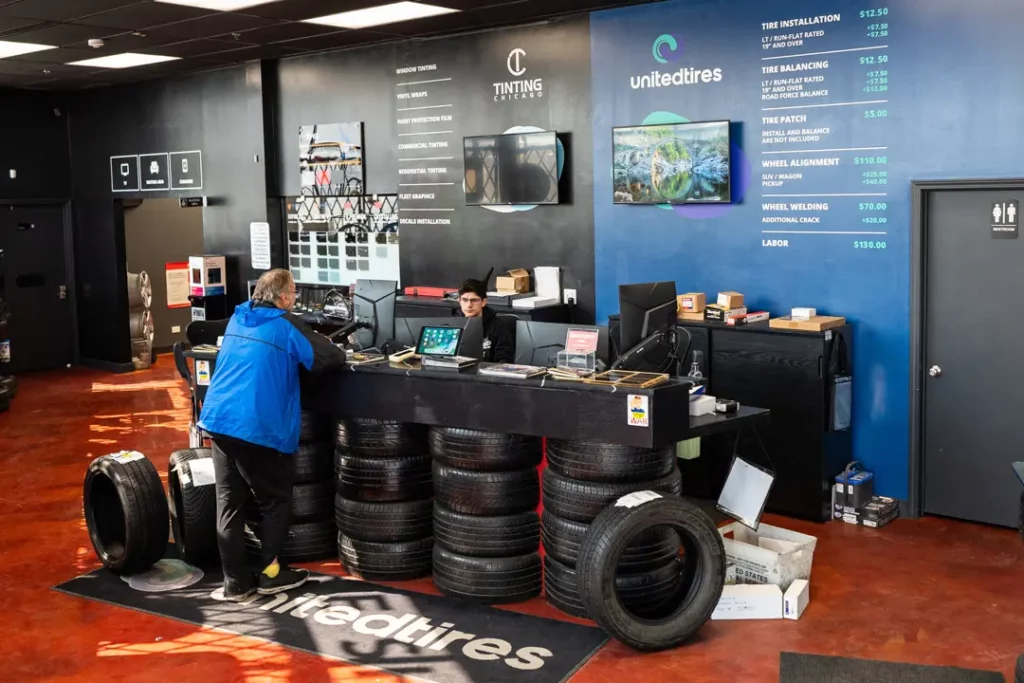
There are tire stores that sell both new and used items, as well as shops that specialize in used car parts. You can go big or small—shop at a small private store or buy tires at Costco or Walmart. Here is a list of prons and cons of “offline” used tire shopping.
Pros
- Good quality tires. Reliable used tires are thoroughly inspected by reputable dealers before sale, making sure that the rubber is still in excellent condition. They can have substantial tread remaining—up to 11/32″! Many drivers replace their tires every few years for safety or preference, and new tire dealers often sell these gently used tires to second-hand shops for resale.
- Experienced staff assistance. You can ask the staff for advice on the type of tire you need, tire mixing, etc., and any other questions about the tire choice.
- Different payment options. In most cases, you can buy used tires with either cash or a credit card—convenience brick-and-mortar stores offer over online shopping.
- Additional services. Some stores offer added services like mounting and balancing for second-hand tires. When you purchase tires from these retailers, you might receive a discount on these services—or even get them for free. Otherwise, expect to pay around $15 to $45 per tire for mounting and balancing at most locations.
- Ability to inspect the tires right away. Before purchasing used tires, take your time to inspect their condition thoroughly. This allows you to choose a tire that best meets your specific needs and priorities.
Cons
- Limited inventory
Tire stores typically offer a limited selection of used tire models, and matching sets may not always be available for your vehicle. However, some shops can order specific tires from their warehouse if they have them in stock. - Possible scam
Some used tire shop owners may try to pass off patched, defective, or even recalled tires. Carefully inspect each tire before purchasing! Unfortunately, some sellers make money by selling scrap tires that look usable but may not be safe. Always be cautious to avoid these risks. You will never have this problem if you choose to shop at Costco or buy tires at Walmart, though. - No warranty
There are no brand warranties, as the tires are usually not from a particular shop but bought from other facilities or sellers. There is nothing to give it to, as the shop takes responsibility only for its choice of items to sell. If you buy used tires from a shop that repairs the pre-mounted tires it sells, you may get a warranty on the service performed.
Junkyards

Junkyards are places that store totaled vehicles that crashed in accidents or those that malfunctioned beyond repair. While some of their parts may be useless, the tires are often very good. Anyone can purchase second-had tires from a junkyard or arrange for delivery to a tire shop.
Pros
- Consultation on tire availability
Before you buy used tires, consult the facility on the availability of the tires you need. Many junkyards have digital databases with information on the availability and location of every car part or tire in stock. They may also help you pick another tire model with the same specifications that are available at the time. - Buying one tire is possible
If only one tire on your vehicle is worn out or if you need to buy spare tire, you can get a good deal at a junkyard. One tire will usually cost you $10-50, depending on its condition. - Opportunity to inspect tires
You have the opportunity to inspect the inner section of the tire, as junkyards usually sell tires without rims. You can check for internal damages, improper repairs, cuts, cracks, and other issues before you buy used tires. - Replacement policy
Some junkyards have a special replacement policy that gives you the right to demand another tire if yours fails too soon. The policies of different facilities usually vary, so you may need to prove to them you didn’t damage the tire yourself.
Cons
- Small chance of finding a matched set
Finding a full set may be a problem, and even if you find the same model and size, their condition may be different. Сars end up in junkyards for various reasons, and some tires from almost new sets get damaged along with their vehicle. - Undetectable damages
Common issues with used tires include uneven wear, belt damage, and flat spots. For instance, a tire previously used on a misaligned wheel may have hidden uneven wear that’s hard to detect initially. Once mounted, however, handling issues can quickly become obvious. Buying used tires with these problems can end up being a waste of money, as not all issues are repairable. - No warranty
Used tires typically don’t come with a warranty, although some facilities may offer replacement policies. This is because there’s usually no record of prior maintenance or details on why the vehicle was taken off the road, making it difficult to guarantee tire reliability.
Online marketplaces

Online marketplaces—Amazon, eBay, Craigslist—can help you buy used tires with a great balance of price and condition.
Pros
- Plenty of options
You may find the same tire model in different conditions and for different prices. So, depending on your priorities, you can choose an option that suits you the best. On Amazon, there are currently over 5,000 listings to choose from. - Opportunity to contact sellers
Contacting the seller directly will help you make the right choice. The more you know about the item, the better your pick will be. You can also ask for a discount or discuss the details of the delivery. - Convenient delivery options
You can choose from a variety of delivery options, such as standard and urgent. Besides, you will save some time, as the package will be delivered to a specified address, and you will not need to travel anywhere to get it. For example, the FedEx delivery from the United Tires shop on eBay is always free! - Option comparison
Some marketplaces offer a list of all available options based on the model, size, and other specifications you’re looking for. These listings typically include a brief description of each tire’s condition, specifications, and price, allowing you to compare options easily. This helps you find the best deals compared to new tires and select the most suitable option. - Seller ratings and reviews
You can find the best seller by looking at their rating. Some marketplaces also provide reviews and comments from clients who buy used tires frequently. This will help you be sure you will get exactly what you ordered for a reasonable price in a short period of time. United Tires shop on eBay has 96% (over 53,400) positive reviews. Aim for shops that have truly deserved their customers’ trust.
Cons
- No guarantee of sellers’ reliability
There’s no guarantee you will get what you ordered, even though Web-based marketplaces may provide safety for your money. You may get the wrong tire, and the seller may be long gone from the service. Besides that, if you have to return the order, it will take additional time and money. - Waiting time
Depending on the marketplace you order from, several days (or sometimes weeks) may pass before you get your package. However, there are special fast delivery options that for a certain amount of money will help you get the item in a matter of days, sometimes hours. - Delivery costs
Some services offer free delivery options that require a week or more of waiting. However, if you want the tires sooner, you may need to pay an extra fee. The cost depends on the weight/size of the order and the time. For example, Amazon provides Same-Day Delivery for $8.99 per order (+$0.99 per item). eBay has a more complicated system for determining delivery costs. - No cash payments
Shopping online requires a credit card or, often, a PayPal account, which may be inconvenient for people without bank accounts.
Online tire stores
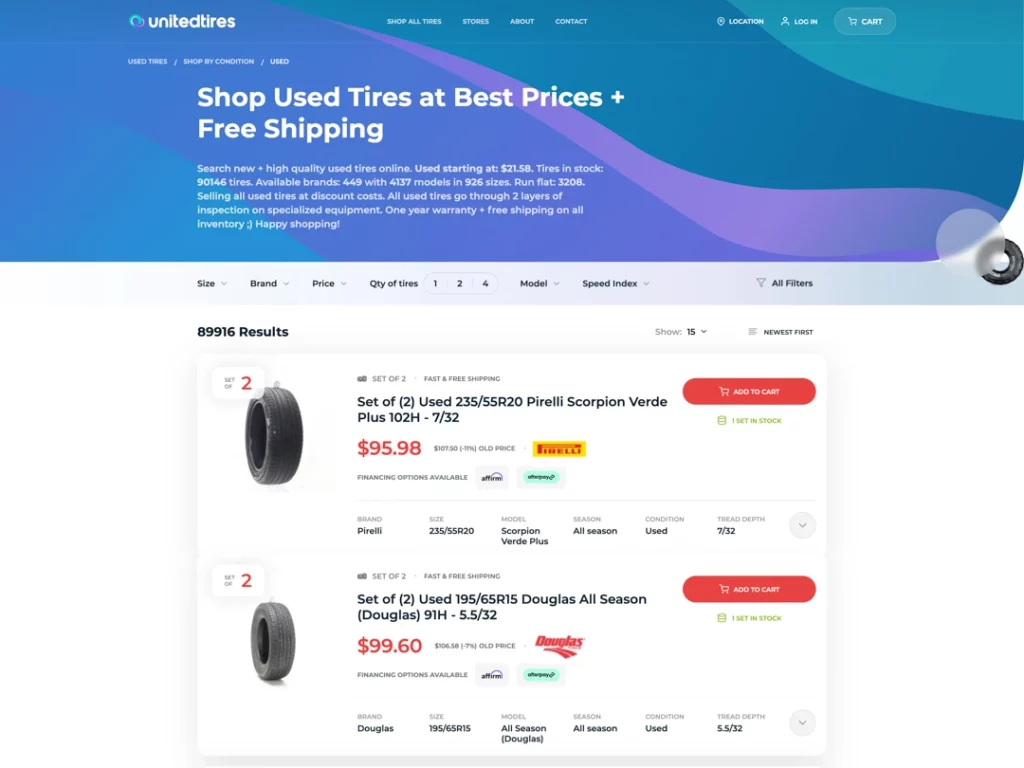
There are online stores that sell used tires as a part of a wider range of inventory and those selling only tires (like United Tires).
The auto parts stores buy car parts from drivers and then resell them at junkyards, tire shops, etc.
Large online tire stores may have contracts with large used tire wholesalers, not purchasing directly from scrapyards and smaller shops. These stores have strict quality control and safety policies. For example, at UTires, each used tire undergoes a thorough 3-stage inspection, both visual and instrumental, on state-of-the-art equipment. We perform water and air pressure tests to make sure there are no leaks, punctures, damages on a sidewall, etc. Damaged tires are discarded.
Pros
- Professional choice. Professional staff test each tire and note any potential drawbacks in the descriptions. Additionally, if you’re uncertain about what you need, the shop’s staff can assist you in making the right choice. As we mentioned, we don’t sell damaged tires, but the tread may have been patched according to the industry standards. And that is clearly reflected in the listing. These tires are usually cheaper.
- Large inventory. Most trustworthy online tire shops have a large inventory of used tires of different sizes, with different tread left, for different prices. Some used tires for sale may be with up to 10/32” tread and only a year old. Yet, more money-saving options may be with 5/32” tread and 5-6 years old. Currently, our selection of used tires consists of about 90,000 items to choose from.
- Convenient search. You can search for the needed items by size, model, car, make, etc., or by clicking the “Search” button. At Utires.com, you can find tires for your particular vehicle model and year.
- Easy shipments. If you buy from a good online tire shop, your order may be delivered right to your doorstep in the blink of an eye. At United Tires, we always ship for free by FedEx. Orders placed before 1 p.m. CST are dispatched from our warehouse on the same business day, which speeds up the delivery.
Cons
- Additional costs
You may have to add up to $100-150 to your spending to install the tires. Not all tire shops will provide mounting and balance for free if you didn’t buy used tires from them. Some services cooperate with tire shops and can recommend you a reliable local facility. - Differences in policies
Money-back guarantees, warranties, and replacement policies can differ between stores. So, before you buy used tires, make sure to read the terms and conditions thoroughly. - Possible scam
There are scammers who create services to sell scrap tires or no tires at all, taking customers’ money and creating false reviews. Before you choose a service, read all the necessary information on their website and ask them questions if you have any. Also, consider reading independent reviews online to find out all the pros and cons of a particular online shop.
Things to check before you buy used tires: tread depth

There are a number of things to check before you get pre-mounted tires:
- Tread depth
Used tires may have different tread left, and the more of it left, the better. 6/32” should be the starting point if you plan to use the tires for at least a couple of years. Don’t get tires that have less than 4/32” tread left—they are bald and dangerous. - Tire age
Find the DOT code on the tire’s sidewall and look at the last four digits. The first two numbers are the week, and the last two are the year of the tire’s manufacture. So, 2309 would be the 23rd week of 2009, and this tire should be considered old by now. It’s better to buy tires that are less than 6 years old. Older tires need to be fully checked every year and can threaten your safety. Rubber starts to deteriorate once the tire is released, and it ages even if not used.
- Recall
Before you buy used tires, check their Tire Identification Numbers (TINs—the letter-numeric sequence after DOT on your tire) using the Rubber Manufacturers Association (RMA) recall search tool. Manufacturers recall tires when they find defects that may be dangerous to the items’ owners. - Damages
Check for cuts, punctures, cracks, and bulges on the tread, sidewalls, and beads. Some scuffing is acceptable, but there should be no obvious damage, however small they are. There may be patches inside, meaning the tire was repaired. As not all the repairs make the tire operational again, buying used tires without repairs is better. Also, look for any cord and wire exposure—there should be none, or the construction of the tire might be damaged. - UTQG code
The Uniform Tire Quality Grading is a system that shows estimates on the tire’s traction, treadwear, and temperature resistance. When you buy used tires, pay attention to the Treadwear grade: the higher the number is, the slower the tire wears. The most optimal variant will be a tire with a grade of 400-600. However, remember that long-lasting tires provide less performance and comfort. - Uneven wear
Uneven treadwear patterns indicate different problems with the vehicle the tires were on and the items themselves. For example, two-shoulder wear shows that the tire was underinflated. This is a frequent cause of blowouts, so you shouldn’t buy such a tire. It will have a short life, wearing as unevenly as it did before and posing a danger to you and your vehicle.
Very cheap tires: hidden dangers
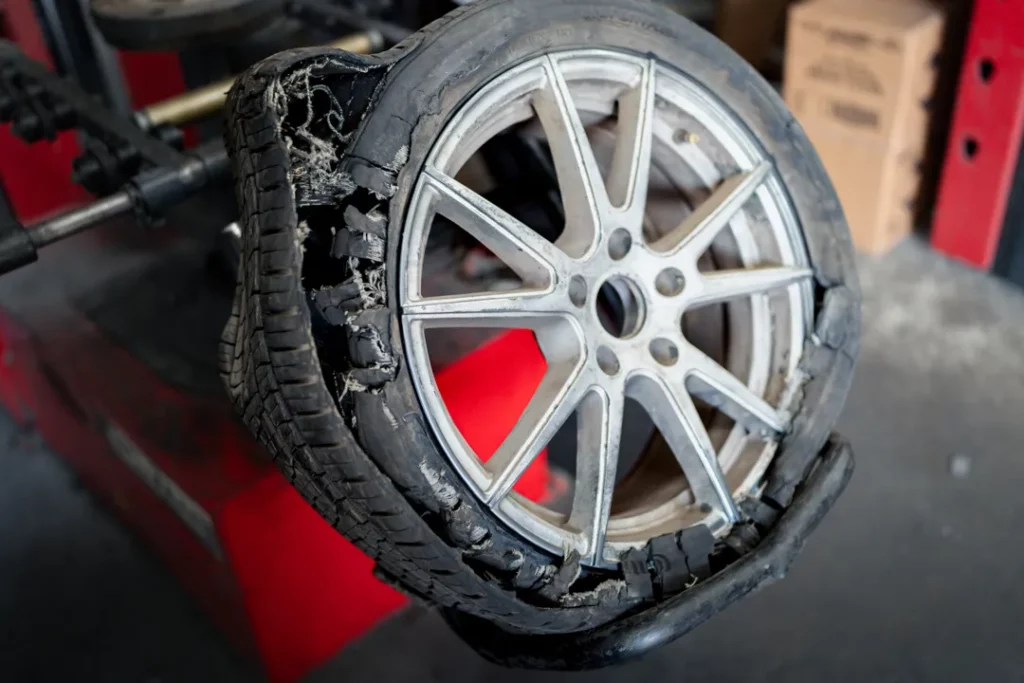
When buying second-hand tires, make sure you know about the following scam techniques some sellers use.
- Scrubbing the date codes off
If a tire is too old yet appears new, some sellers may remove the date code from it. Tire aging is dangerous, and once you mount such a tire, the tread can separate at any moment. Dry cracks will be increasing in size rapidly when you inflate the tire. - Improper repairs
When the irreparable damages are fixed, the tire loses air, and the damage expands. For example, ozone cracks are irreparable, as once the reaction starts, it’s impossible to stop it. However, some people patch those cracks and sell them as “professionally repaired.” - Regrooving
Some worn-out tires can be illegally regrooved to meet legal tread depth requirements. Such tires are prone to damage, as there is much less rubber left on them. Using such tires is also illegal, and you may be later fined to pay up to $1,000 per tire. - A potential loss of car insurance
Another drawback is the potential risk of losing your vehicle insurance. While some tires are manufactured to allow safe regrooving, which you can identify by markings on the tire’s sidewall, most tires aren’t designed for this life-extending technique. Attempting to regroove unsuitable tires can compromise safety and coverage.
- Selling counterfeit tires
Fake tires are manufactured to resemble the products of famous companies, but the materials are usually of lower quality. Such tires may bring a number of issues. Their tread life is completely unexpected, and they are also illegal. There is a troubling report about fake tires entering the US market, so it’s better not to buy used tires that are suspicious. It’s vital that you check every bit of code before you buy used tires. Manufacturer facility, TIN, and date codes are especially important, as companies detect their tires using them. If the information seems suspicious, contact the authorized dealers to check it. - Repainted tires
Some sellers paint old tires over to make them look newer, as tires usually lose their deep dark color when aged. They might claim the tires were properly stored and are still functional despite their age. However, once mounted, these tires can reveal issues, such as unusual vibrations that may damage both the tire and the wheel. Older tires often have hidden cracks that allow air to escape, increasing the risk of blowouts. Additionally, worn tires may barely hold together, leading to the tread separating from the tire after a short distance, which poses serious safety risks.
Where should I buy used tires: 5 options
Your choice should depend on your priorities:
- Go to the closest junkyard if you need one or two used tires in relatively good condition
- Consider online marketplaces if you have time to wait and want a wide selection to find the best quality and price balance. Buying directly from other drivers can offer a variety of options to suit your needs.
- Choose an online car parts shop if you need an online consultation before choosing tires or help with the choice.
- Shop from a reliable online tire store
- Visit a local tire shop if you need on-site advice and prefer inspecting the tires yourself before purchase.
Despite the potential drawbacks, around 30 million used tires are sold annually in the U.S., accounting for about 10% of the tire market. This indicates that many drivers find the benefits of purchasing second-hand tires appealing.
Benefits of buying used tires

Purchasing used tires can offer several benefits, making them an attractive option for many vehicle owners. Here are some key advantages:
- Cost savings: Cost savings are one of the most significant benefits of buying used tires. Used tires are significantly cheaper than new ones, making them an affordable option for those looking to save money on vehicle maintenance. Whether you need truck tires, car tires, or passenger tires, opting for used tires can help you stay within your budget. You can save up to 50% and even more from the new tire prices!
- Matching tires: Used tire shops offer the great possibility of buying one (two, three) tires to match the tread wear of your current set. You don’t need to perform a total changeover in case only one tire is damaged; you can find the exact same model and size with exactly the same tread wear and be happy!
- Buy driven once tires. This unique category features tires that were only tried on but never actually used. Basically, they are new tires sold for much cheaper, as used tires. Shop smart and save cash!
- Environmental benefits: Buying used tires is an environmentally conscious purchase. By choosing pre-owned tires, you help reduce waste and conserve natural resources. You also support your state’s tire disposal efforts by giving tires a second life. This helps reduce the need for new tire production. And prevents early landfill: shop for used tires to make your impact.
- Quality-assured tire shopping: Reputable tire stores like ours maintain good standing with used tire buyers. Strict quality control guarantees the high quality of all used tires in the inventory. And if any issues are detected, you can always claim a return by getting in touch with our friendly 24/7 customer support by dialing 1-888-566-6214.
Buying quality used tires is a smart choice that offers quite a few benefits, including significant cost savings and environmental protection.
Frequently Asked Questions
Where to buy used tires?
You can buy used tires in a local tire store or auto repair shop, at the junkyard, at online marketplaces, at a specialized auto parts shop, or at an online used tire store.
What’s the best place to buy used tires?
We would recommend shopping with reputable used tire retailers like United Tires. By choosing a reliable shop with hundreds of thousands of positive customer reviews, you can be sure of the high quality and safety of the used tires you buy. Plus, a reliable and fast delivery, in our case, free, right to your doorstep, by FedEx. Another good option is your local tire store, but the inventory may be limited.
How much are used tires?
The price of used tires may vary between $25 and $250 and will depend on the brand, model, and the condition of a tire.
Share the Knowledge
